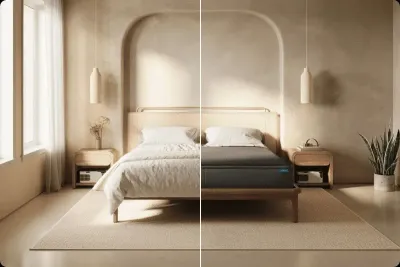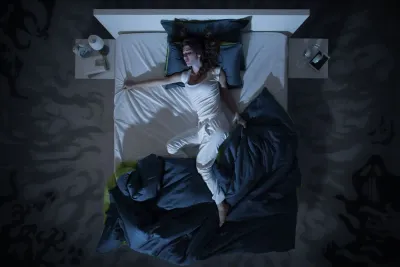
Key Takeaways
- Lighting Matters: Swap harsh overheads and blue light for softer, warmer tones that tell your brain it’s time to wind down.
- Cool Comfort: Aim for about 65°F for deeper, more restorative sleep. Cooling mattress toppers or bed cooling systems make hitting that temp a breeze.
- Decluttered Space: A tidy, minimal room keeps distractions low so your mind can switch off faster.
- Sound Strategy: White noise machines and blackout curtains help block out the stuff that interrupts your sleep—whether it’s traffic, neighbors, or streetlights.
- Purposeful Design: Leave work and screens at the door. Keep your bedroom a true sleep-only zone, reinforcing the mental link between your bed and solid sleep.
Your bedroom setup plays a huge role in getting consistent, quality sleep. A sleep-friendly space isn’t just nice to have—it’s a core part of good sleep hygiene.
Think of it as setting the mood: soft, soothing lighting, steady calming sounds, and even scents that help your body relax. When these elements work together, they create a peaceful atmosphere that makes drifting off easier and staying asleep more natural.
Let’s break down the key ways you can fine-tune your bedroom to become the ultimate sleep haven.
1. Bedroom Light
The importance of lighting in regulating our sleep patterns cannot be overstated. In order to achieve restful sleep, it is important to create a peaceful environment that promotes both sleep and relaxation.
This can be done by using dim, warm lighting, as it has been shown to be most effective in inducing a state of calm and preparing the body for sleep. Consider installing dimmer switches or low-wattage bulbs for adjustable lighting.
Want to take your evening lighting up a notch? Swap in red light bulbs where you usually flip the switch at night. It’s like bringing the sunset into your bedroom. Your brain naturally ties that kind of light to winding down—a cue it’s picked up since, well, forever.
Blackout curtains—like the Sleepout brand panels—are a game-changer for deeper rest. They shut out streetlights and morning glare, wrapping your room in total darkness. The result? You fall asleep faster and wake up feeling more refreshed.
Did You Know: Bright light at night can throw off your body’s sleep-wake rhythm and lower melatonin—the hormone that tells your brain it’s time to get sleepy. [1] Curious about boosting melatonin naturally, without supplements?
Related: Your body’s circadian rhythm plays a major role in how well you sleep. Learn how circadian rhythm works and how to keep it on track in our full blog.
Blue light is another sleep thief; late-night scrolling makes it harder to fall asleep. AIs there an easy fix? Yes, it can be challenging, but power down your screens earlier. It’s a small change with a big payoff.
If you do need to be on a screen or around bright lights at night, throw on a pair of amber blue light–blocking glasses. They filter out the stimulating blue light that keeps your brain wired when it should be winding down.
2. Temperature Control: Finding Your Comfort Zone
Sleep loves cool air, and when it's around 65°F (18°C), it hits the sweet spot for most people. Too warm, and you’ll toss and turn. Too cold, and you’ll wake up uncomfortable.
Bedroom air quality is also important. If possible, crack a window, leave a door open, or run an air purifier to keep things clean and breathable. Not a fan of open windows? A fan or AC works just as well to balance temperature and humidity.
Want a natural boost? Add a snake plant to your bedroom. It filters indoor air and keeps your room feeling fresher—and yes, a little greener.
The goal is to keep the air moving, cut the stuffiness, and create a bedroom that makes it easy to fall asleep and get better sleep.
Upgrade Your Sleep Environment
Bring in a Chilipad Dock Pro or Cube, and you’re not just cooling your bed—you’re dialing in the perfect temperature for deeper, more refreshing quality sleep.
3. The Importance of Color
The colors in your bedroom do more than just look nice; they set the mood for how you feel and how well you sleep. Soft, warm tones tend to create that cozy, calming atmosphere that helps you actually relax at night.
But here’s the thing: the “right” color is the one that feels good to you. If a certain shade makes you feel comfortable and ready to unwind, that’s your sleep color.
Not ready for a full wall makeover? No problem. You can add pops of soothing color with throw pillows, blankets, artwork, or even a bold bedspread. Swapping a few white bulbs for red or orange ones also shifts the atmosphere instantly, making the room feel softer and more inviting.
Design isn’t just about looks—it’s about building a space that feels like a reset button the moment you walk in.

Which Bedroom Color Works Best?
Light blue is one of the most relaxing choices you can make for a bedroom. It feels like the sky or a calm ocean, which naturally helps the room feel more peaceful. This shade is known to ease stress, calm the mind, and even lower blood pressure, making it easier to unwind at the end of the day. [2]
It’s a simple color switch that can create a restful, soothing atmosphere for better sleep.
4. Minimalist Furniture
The way you arrange your bedroom furniture can make a big difference in how well you sleep. A clean, open layout feels less cluttered and instantly more calming, helping you unwind at night.
Feng Shui principles suggest placing your bed where you can see the entrance and natural light without being directly in line with the door. This simple shift can add a sense of security and ease, making it easier to fall asleep.
Giving your bed some space to “breathe” not only makes the room more comfortable but also improves how the whole space feels—both physically and mentally. With the right arrangement, your bedroom transforms into a peaceful retreat that supports better rest.
Read More: Basic Cleaning Tips for Your Bedroom to Promote Sleep
5. Selecting the Perfect Cozy Bed
Your bed and mattress are the heart of your bedroom, so choosing the right one matters. Start by thinking about how you sleep whether you need something firm, soft, or in between. Your body type, body temperature, weight, or even past injuries can affect what feels most supportive.
Take time to compare different brands and read reviews to see what works well for others. If you can, try out mattresses in-store or with at-home trials to make sure the one you choose gives you the comfort and support you need for sleep.
Read More: What is The Best Sleeping Position
Choose bedding that feels soft, breathable, and comfortable against your skin. Materials like cotton and linen are great picks since they’re airy, durable, and naturally hypoallergenic, perfect for keeping your sleep space healthy and fresh.
If you tend to sleep hot, be aware that memory foam often holds onto body heat. You can find helpful tricks to stay cooler here: how to make your memory foam mattress cooler.
Cooling Bed Systems: Customizing Your Sleep Temperature
A good mattress is important, but adding a cooling system can take your sleep to the next level. Options like the Chilipad Dock Pro, the best cooling mattress topper, or the original cooling pad for your bed, the Cube, allow you to set and control your bed temperature, helping you stay comfortable all night long.
By keeping your body at the right temperature, these systems create an ideal sleep space for deeper, more restful sleep.
6. Creating a Calming Atmosphere
The right ambiance can make your bedroom feel like a true retreat. Soft touches—like cozy rugs, supportive pillows, or breathable bamboo sheets—add comfort and help you settle in.
Lighting also makes a big difference. Swapping harsh lights for warm, dimmable lamps creates a relaxed mood that eases you into sleep.
Scents can play a role too. Lavender, chamomile, and other calming aromas are known to help with falling asleep and staying asleep. Try using essential oils, candles, or a diffuser to fill your space with soothing notes for a more restful experience.
Tip: If you keep a TV in your bedroom, consider moving it out. While watching shows might feel relaxing, the screen actually keeps your brain stimulated and makes it harder to fully wind down for quality sleep.
7. Noise Management
Unwanted noise can easily disrupt your sleep, so creating a quieter bedroom is key. A white noise machine can help by masking outside sounds with a steady, calming hum, making your space feel more peaceful.
Even a small adjustment can have a big impact on your sleep quality. And if you’re curious, there are different “colors” of noise—like pink noise—that offer their own unique benefits. Learn more about pink noise and how it differs from white noise.
8. Personal Touches: Make It Your Own
The way you set up your bedroom can influence how relaxed and rested you feel. Adding personal touches, like your favorite colors, cozy sheets, or a few photos that make you smile, can make the space feel comforting and safe.
When your room feels more like you, it’s easier to unwind at night, fall into deeper sleep, and wake up ready for the day ahead.
Bedroom Comfort Tips: Time to Get Started
The way your bedroom feels has a big impact on how well you sleep. A few small changes can turn it into a calm, welcoming space that helps you rest more deeply. It’s not just about making your room look nice—it’s about creating an environment that supports your mood, your health, and your sleep.
With the right touches, your bedroom can become a true retreat where you recharge every night.
Frequently asked questions
What Are the Best Colors for a Sleep-Friendly Bedroom?
Stick to cool, calming hues like soft blues, greens, and muted grays to enhance your bedroom environment. They help lower stress and promote a peaceful vibe and allowing you to get a good night's sleep.
How Does Mattress Placement Impact Sleep?
Surprisingly, a lot. Placing your bed where it feels secure, like against a solid wall, and away from doors or high-traffic areas can help you feel grounded and relaxed.
What Bedroom Features Can Help You Sleep Better?
Try these design-forward upgrades for optimized sleep hygiene:
- Blackout curtains to block intrusive light
- White noise machines or smart speakers for ambient sound
- Cooling mattress toppers or sleep systems like Chilipad
- Clutter-free layout to reduce anxiety
- Plants like lavender or snake plants can enhance the air and ambiance
Citations / Resources
[1] Tähkämö, L., Partonen, T., & Pesonen, A. K. (2019). Systematic review of light exposure impact on human circadian rhythm. Chronobiology international, 36(2), 151–170. View Study
[2] Liu, W., Ji, J., Chen, H., & Ye, C. (2014). Optimal color design of psychological counseling room by design of experiments and response surface methodology. PloS one, 9(3), e90646. View Study








